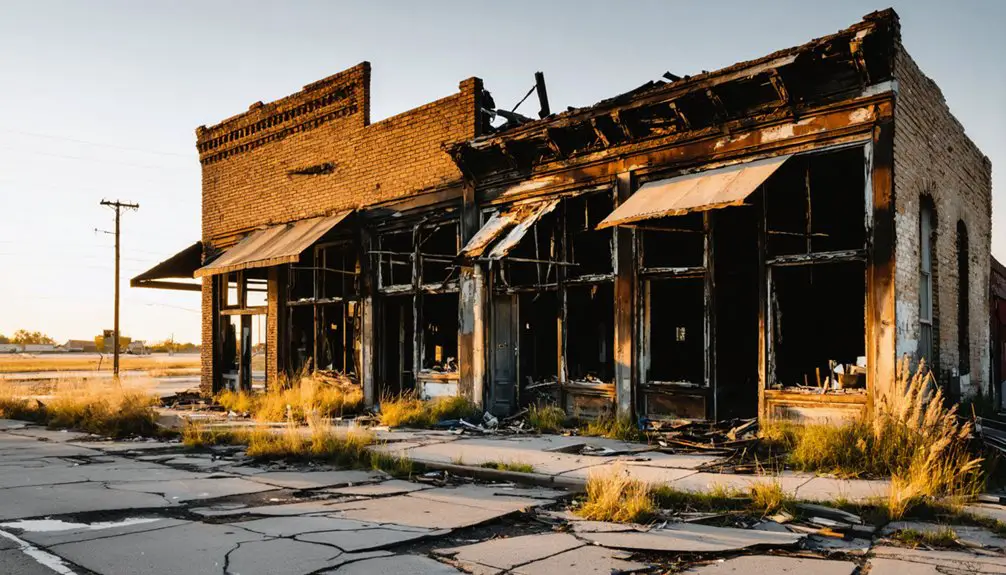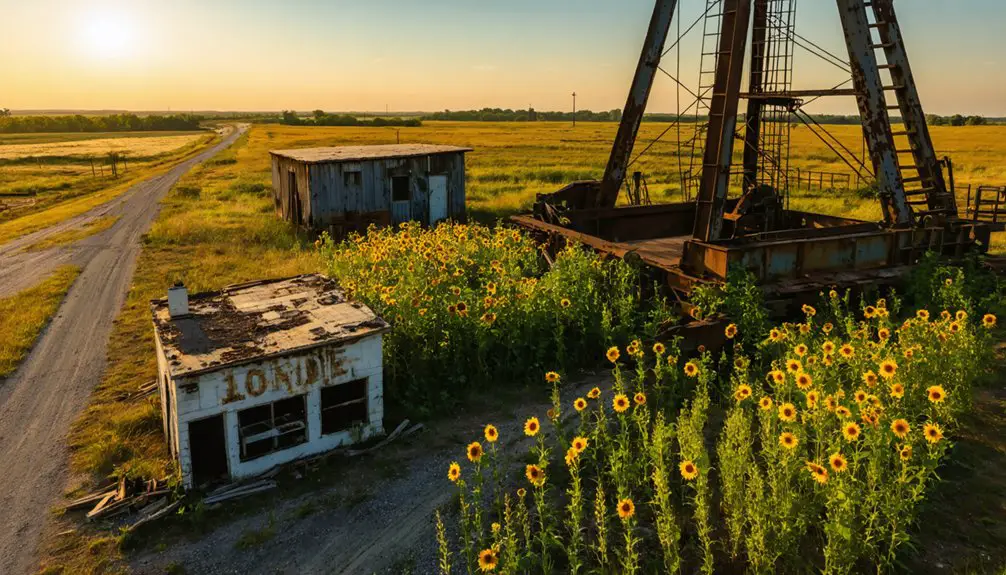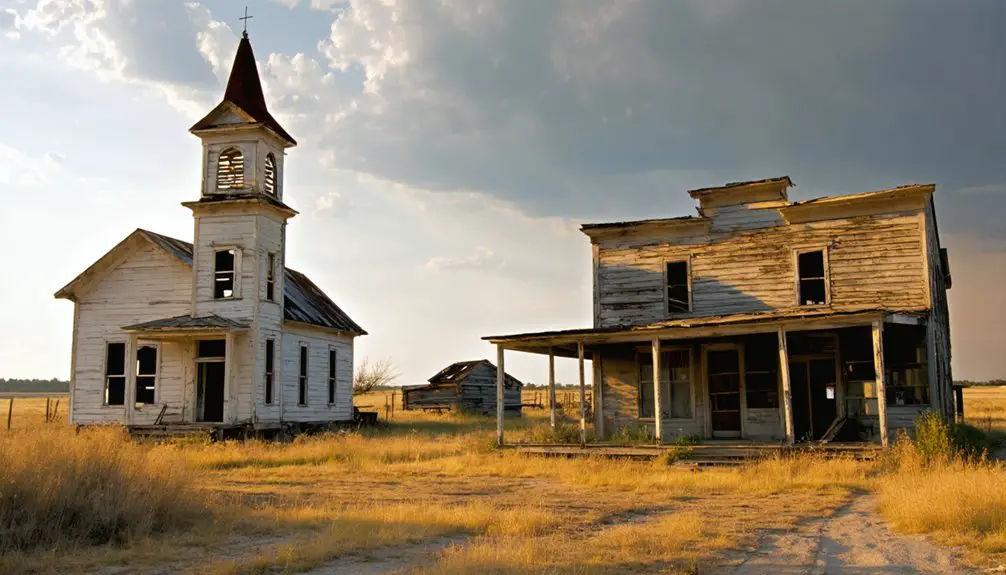You’ll find Roxana’s ghost town remnants where Island Park once stood before the 1927 McCully No. 1 Well transformed it into a bustling oil boomtown. The well, Oklahoma’s first to exceed a mile in depth, drew 1,000 residents within a year as Roxana Petroleum Company’s operations peaked at 25,000 barrels daily. Today, only scattered foundations and a historical marker hint at this former wildcatter settlement’s dramatic tales of bootleggers, shootouts, and oil fortunes.
Key Takeaways
- Roxana emerged from Island Park during the 1920s oil boom, growing to 1,000 residents after the historic McCully No. 1 Well discovery.
- The town flourished around Roxana Petroleum Company’s operations, producing 25,000 barrels daily and operating a 400-mile pipeline to Illinois.
- Workers endured harsh living conditions in company villages and makeshift camps while facing daily hazards from toxic chemicals and fire risks.
- Today, only scattered foundations and a historical marker remain at the abandoned townsite, with vegetation reclaiming the former boomtown.
- The town’s decline followed the oil boom’s end, leaving behind a legacy of Oklahoma’s early petroleum industry development.
The Birth of a Boomtown: From Island Park to Roxana
While many Oklahoma boomtowns emerged during the 1920s oil boom, few underwent such a dramatic transformation as Island Park, which would soon become known as Roxana.
Similar to E.W. Marland’s discovery, the area’s first oil strikes set off a chain reaction of rapid development and population growth.
You’d have witnessed a remarkable economic transformation as the discovery of significant oil reserves turned this quiet area into a bustling hub of activity almost overnight.
The town grew quickly to reach 400 residents after the successful drilling of the McCully No. 1 Well.
The town’s identity shifted rapidly from a natural setting of tents and makeshift shacks to a structured boomtown teeming with workers and entrepreneurs.
From canvas tents to organized streets, the boomtown’s metamorphosis brought waves of ambitious souls seeking prosperity in oil-rich soil.
When you’d have visited during this period, you’d have found a place reinventing itself, shedding its naturalistic name of Island Park to embrace its new destiny as Roxana.
This rebranding reflected the town’s integration into the broader oil industry networks, marking its evolution from rural outpost to industrial frontier.
Striking Black Gold: The McCully Well Legacy
On June 29, 1927, the Roxana Oil Company made Oklahoma history when they drilled the McCully well to a depth exceeding 5,280 feet, marking the state’s first oil well to reach beyond a mile deep.
The McCully impact transformed the region, as advanced drilling techniques of the era enabled this unprecedented achievement. Much like Guthrie National Bank‘s pioneering status as the first brick structure in Oklahoma Territory, this well established new frontiers in the state’s industrial development. You’ll find this milestone sparked rapid development in Logan County’s oil industry, leading to significant regional growth. Located on Highway 51’s north side, the historic site stands as a testament to Oklahoma’s oil heritage.
- Attracted 1,000 residents within a year of drilling
- Established Roxana as Oklahoma’s first oil boom town
- Connected to Royal Dutch Shell’s broader operations
- Contributed to the development of the Sooner Trend
- Led to further deep-well exploration across Oklahoma
The well’s success bolstered Oklahoma’s reputation in the U.S. oil industry, though Roxana’s prosperity proved short-lived as the boom eventually faded into ghost town status.
Wild West Tales and Outlaw Stories
You’ll find that Roxana’s most infamous outlaw tale centers on Don Jagger’s death in a fierce shootout that brought unwanted attention to the bustling oil town.
During the boom years, bootleggers took full advantage of Prohibition-era demands, running illegal liquor operations that served the thirsty oil field workers. Roxana Petroleum Company, established in 1912, brought rapid growth and development to the region before the town’s decline. Like the ancient Roxana from Bactria, the town’s name reflected its brief but dramatic impact on history.
The combination of quick oil money and illegal alcohol created a powder keg of violence, with frequent payday brawls and shootouts erupting throughout the town’s short-lived heyday.
Don Jagger’s Fatal Shootout
Though modern-day Oklahoma has largely moved beyond its frontier past, a deadly 2025 shootout near the ghost town of Roxana echoed the state’s Wild West history.
When you study the shootout aftermath between Logan County deputies and Don Jagger, you’ll find law enforcement tactics that proved both heroic and effective.
Deputies encountered Jagger at a rural residence, where he opened fire with a high-powered rifle. The officers coordinated with US Marshals for backup.
- Two deputies sustained gunshot wounds but survived
- Officers used vehicles and structures as tactical cover
- Body camera footage captured the intense firefight
- Medical teams staged nearby to assist the wounded
- Deputies secured the scene after Jagger was killed
Emergency responders faced challenges accessing the scene near Midwest Boulevard, which delayed immediate response times.
The incident, while tragic, demonstrated how modern law enforcement confronts armed suspects while protecting civilian lives – a challenge that’s evolved since Oklahoma’s territorial days.
Bootlegging During Oil Boom
When oil was discovered near McCully in 1927, Roxana transformed into a bustling boomtown that attracted not just oil workers but also bootleggers keen to profit from Oklahoma’s prohibition laws.
The town’s bootlegging culture thrived as smugglers established illicit networks, operating covert stills and using the maze of oilfield roads to transport illegal alcohol under cover of darkness. Royal Dutch-Shell’s investment in the region’s oil properties had inadvertently created perfect conditions for bootlegging operations.
You’d find bootleggers connecting with larger regional syndicates, using waterways and rail lines to move their contraband while dodging federal agents.
Local saloons served as fronts, mixing legitimate business with underground sales.
The outlaw spirit manifested in armed confrontations between rival bootleggers and law enforcement, spawning tales of shootouts and hidden liquor caches that became part of Roxana’s Wild West folklore. D. Earl Newsom’s research extensively documented these violent clashes between lawmen and bootleggers during the town’s peak years.
Life During the Oil Rush Years
You’d find workers at Roxana Petroleum Company laboring through long shifts in hazardous conditions during the 1910s oil rush, with many earning their wages in the refinery’s early crude processing operations.
Your housing options would’ve been limited to the company-built village of Roxana, where Shell constructed basic accommodations to handle the influx of oil workers and their families.
If you’d lived there during the boom years, you’d have experienced the typical challenges of an early oil town – basic infrastructure, crowded conditions, and a lifestyle completely centered around the refinery’s demanding 24-hour operations.
Daily Life and Work
During the oil boom years of Roxana, life revolved around the demanding rhythms of petroleum extraction and refining.
You’d find worker camaraderie forged in the hazardous conditions of 1918’s Roxana Petroleum, where roughly 175 workers braved long shifts operating Trumble units and laying pipelines.
The town’s economic resilience stemmed from the steady flow of oil money through local establishments.
- Drillers and refinery hands worked grueling outdoor shifts, constantly exposed to flammable materials and crude oil.
- Biweekly or monthly paychecks sparked bursts of commerce in local stores and saloons.
- Workers found relief in gambling, informal sports, and occasional traveling shows.
- Bootlegging and prostitution flourished alongside legitimate businesses.
- Living conditions centered around company housing and boarding houses, creating tight-knit worker communities.
Rough Living Conditions
Life in Roxana’s oil boom brought harsh realities for workers and their families, who endured cramped conditions in hastily built boarding houses and makeshift camps scattered across the oil fields.
You’d find yourself sharing overcrowded accommodations with dozens of other workers, often with minimal privacy and basic amenities.
Sanitation issues plagued these temporary settlements, where proper waste management was virtually non-existent.
You’d face daily exposure to toxic chemicals from leaking wells, while the constant threat of fires and explosions loomed over the community.
The lack of infrastructure meant you’d struggle with contaminated water sources and hazardous living conditions.
Without modern safety regulations, you’d be at the mercy of these dangerous environments, where both your health and safety were constantly at risk.
The Great Fire and Economic Decline

While historical records don’t detail a specific great fire in Roxana, the town’s fate mirrored other Oklahoma boomtowns of the era that succumbed to devastating fires and economic downturns.
The combination of fire hazards and economic instability proved devastating for these rapidly-built wooden settlements.
- Nearby towns like Muskogee and Claremore lost entire commercial districts to massive fires
- Limited firefighting capabilities relied mainly on bucket brigades
- Wooden structures packed tightly together created perfect conditions for rapid fire spread
- Economic disruption from fires could paralyze local commerce for months or years
- Oil production fluctuations left boom towns particularly vulnerable to decline
These challenges, common to oil boomtowns of the era, demonstrated how quickly fortunes could change in Oklahoma’s wild frontier settlements, where prosperity and ruin often walked hand in hand.
What Remains: Traces of Yesterday
Today’s visitors to Roxana’s abandoned townsite will find only scattered foundations marking where buildings once stood during the oil boom era. The foundational ruins lie on private property, and you’ll need to view them from the roadside where a historical marker stands as the sole public evidence to the town’s existence.
While you can’t access the site directly, you’ll spot the physical remnants of this once-bustling community from the north side of the road. The surrounding landscape has returned to its natural state, with vegetation reclaiming the land where homes and businesses once thrived.
The site’s historical significance is preserved through documentation in *Chronicles of Oklahoma* and local archives, though the physical traces continue to fade with each passing year.
Historical Impact on Oklahoma’s Oil Heritage

These scattered ruins mark more than just a forgotten town – they represent a defining chapter in Oklahoma’s oil heritage.
When Roxana Petroleum launched its oil exploration efforts in 1912, you’d witness the beginning of an economic transformation that would reshape the state’s future. The company’s strategic development created a fully integrated operation that revolutionized Oklahoma’s oil industry.
- First mile-deep well in Oklahoma struck at No. 1 McCully site
- Peak production of 25,000 barrels daily from 14 wells
- Construction of a 400-mile pipeline to Wood River refinery
- Implementation of advanced Trumble distillation technology
- Creation of overnight millionaires from local farmland owners
You can trace Roxana’s influence through its pioneering achievements in drilling, refining, and distribution infrastructure that set standards for Oklahoma’s emerging petroleum industry.
Frequently Asked Questions
What Happened to the Residents After Roxana Became a Ghost Town?
You’ll find relocation stories of former residents scattering to nearby towns and cities for jobs, while maintaining community memories through historical markers. Some moved to urban centers during the Great Depression.
Were There Any Native American Settlements in the Area Before Roxana?
While you might expect pristine wilderness, Native American settlements thrived there for centuries. You’d have found Osage and later Cherokee communities using the land for agriculture, hunting, and ceremonial grounds.
How Much Did Property Values Change During the Boom and Bust?
While exact property appraisals aren’t recorded, you’d have seen market fluctuations from nearly worthless farmland to sky-high values during the oil boom, then back to practically nothing by 1930.
What Role Did Railroads Play in Roxana’s Development and Decline?
You’ll find railroads drove Roxana’s early success by enabling Shell’s oil transport and market access, but their declining importance and economic shifts toward pipelines later contributed to the town’s eventual abandonment.
Did Any Famous People Besides Don Jagger Visit or Live in Roxana?
You won’t find evidence of any famous visitors or notable residents in historical records beyond Don Jagger’s notorious presence. The town’s population consisted mainly of oil workers seeking fortune.
References
- https://www.okhistory.org/about/markers?action=Search&county=Logan
- https://www.youtube.com/watch?v=8o4cJVEXlOo
- https://gateway.okhistory.org/ark:/67531/metadc2031652/
- https://www.youtube.com/watch?v=5NI-cU4nQ6w
- https://www.ghosttowns.com/states/ok/roxana.html
- https://nondoc.com/2022/01/04/whizbang-oklahoma-ghost-town/
- https://gateway.okhistory.org/ark:/67531/metadc1741351/m1/66/
- https://archivesspace.library.okstate.edu/repositories/3/archival_objects/84579
- https://www.waymarking.com/waymarks/WM17CDY_FIRST_Oil_Boom_Town_in_Logan_County_Oklahoma
- https://wrrmuseum.org/index.php/1910s/



